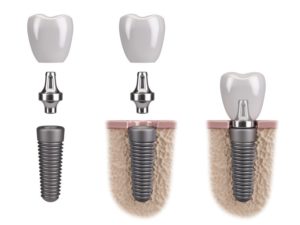
Have you ever been to the dentist and felt like you weren’t on the same page? Did it feel like they were speaking a different language? It can be challenging to keep up with all the terms that dental professionals use to talk about complex procedures—especially Dental Implants. In this post, you’ll become familiar with the definitions of common dental implant terms you’ll most likely hear. By taking the time to learn these terms, you can make more informed decisions and have confidence in your treatment choice.
Dental Implant
This is a phrase you are very likely to hear multiple times. A dental implant is the closest thing that dentistry has to replace the entire missing tooth’s structure starting from the root in the jaw bone all the way up to crown above the gum’s surface. This option is usually recommended by dentists because of their long-term health benefits, including better nutrition and stronger jaw bone and support for your remaining healthy teeth. Overall, dental implants are successful over 95 percent of the time even 10 years after they are placed.
Post
Occasionally, dentists can use dental implant to specifically refer to the post. It usually consists of titanium, a biocompatible material that is used in other areas of the body, such as in knee or hip replacements. Your dentist surgically places the post into your jaw bone below the gums in the lost tooth’s socket. Once it is fully bonded to the jaw bone, it serves as your implant’s foundation that keeps it firmly in place and allows you to enjoy the same biting force as you had with natural teeth.
Osseointegration
After the post has been placed through a minor surgical procedure, you must wait for several months to allow a process called osseointegration to occur. In osseointegration, the post stimulates the jaw bone to continue growing and surround the post. This process keeps the jaw bone strong—just like a natural tooth—and allows the dental implants to bear increased biting force required to bite and chew nutritious foods.
Abutment
Once osseointegration has happened, your dentist will then attach the abutment. This piece connects the post to the dental prosthetic.
Restoration
Finally, the term restoration refers to the dental prosthetic that goes on top of the abutment. For a single missing tooth, it is a dental crown. In cases of multiple missing teeth, dental bridges or even dentures can be attached to fully replace the missing tooth and complete the dental implant. Regardless of the type of restoration that you get, you can rest assured that it will remain securely in place and help you regain your smile’s function, strength, and beauty.
Understanding these terms can help you better comprehend this sophisticated, effective tooth-replacement option. That way, you can be sure that you’re making the right choice and getting the most benefits from your restored smile. If you have questions about dental implants or other terms, contact your dentist—they will be happy to explain dental implants to you in more depth.
About the Practice
At Beach Dental, three dentists are available to help patients who are interested in learning more about dental implants. We love to explain things! Each dentist has years of dentistry experience and advanced training, including with Spear Education and other prestigious organizations. To ask them about dental implants or to schedule a consultation with them, you can call (631) 325-0731 or click here.

